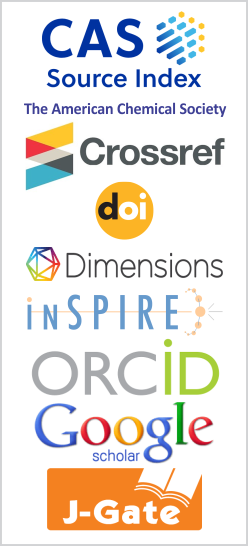Electronic Excited States of the Dihalomethanes, \(\rm CH_2X_2 \ (X=Cl, Br, I)\)
DOI:
https://doi.org/10.26713/jamcnp.v2i3.349Keywords:
Excited states, Dihalomethanes, Rydberg series, VUV photoabsorption, Vibronic structureAbstract
The vacuum ultraviolet (VUV) photoabsorption spectra of the dihalomethanes \(\rm CH_2X_2 \ (X=Cl, Br, I)\) are studied using synchrotron radiation in the energy region 6–11.8 eV (\(\sim\)49,000–95,200 cm\(^{−1}\)). A detailed comparison is made to identify similarities, differences and trends in the spectra and excited state structure of these three molecules. The electronic spectra of the dihalomethanes in this region are dominated by Rydberg series of \(ns\), \(np\) and \(nd\) type. Quantum defect analysis reveals that the Rydberg series in all the dihalomethanes originate from the four outermost halogen lone pair non-bonding orbitals. On going from Cl to I, the energy difference between the first four ionization potentials decreases which as a consequence leads to spectral congestion and complications in spectral assignments. In all three molecules, several Rydberg transitions are accompanied by vibrational structure. A notable common feature seen in the vibronic structure is the excitation of the \(\nu_3\) (\(\rm C\)\(\rm -\)\(\rm X\) symmetric stretch) mode to form extensive progressions. Additionally, the \(\nu_1\) (\(\rm C\)\(\rm -\)\(\rm H\) symmetric stretch), \(\nu_2\) (\(\rm CH_2\) bend) and \(\nu_8\) (\(\rm CH_2\) wag) modes are observed in \(\rm CH_2Cl_2\) and \(\rm CH_2I_2\), although they do not form long progressions. Quantum chemical calculations of ground and excited states are used to support the analysis and an improved theory-experiment comparison is provided for \(\rm CH_2Br_2\).Downloads
References
T.J. Johnson, T. Masiello and S.W. Sharpe, Atmos. Chem. Phys. 6, 2581 (2006).
M.B. Robin, Higher Excited States of Polyatomic Molecules, Vol. 1 (Academic Press, New York, 1974).
A. Mandal, P.J. Singh, A. Shastri and B.N. Jagatap, J. Quant. Spectrosc. Rad. Transfer 149, 291 (2014).
A. Mandal, P.J. Singh, A. Shastri, V. Kumar, B.N.R. Sekhar and B.N. Jagatap, J. Quant. Spectrosc. Rad. Transfer 144, 164 (2014).
A. Mandal, P.J. Singh, A. Shastri and B.N. Jagatap, J. Chem. Phys. 140, 194312 (2014).
A. Shastri, B.N. Raja Sekhar, P. Jeet Singh and M.N. Deo, Spectrosc. Lett. 42, 219 (2009).
P.M.R. Rao, N.C. Das, B.N. Raja Sekhar, S. Padmanabhan, A. Shastri, S.S. Bhattacharya and A.P. Roy, Nucl. Instr. Meth. Phys. Res. A 613, 467-468 (2001).
M.W. Schmidt, K.K. Baldridge, J.A. Boatz, S.T. Elbert, M.S. Gordon, J.H. Jensen, S. Koseki, N. Matsunaga, K.A. Nguyen, S. Su, T.L. Windus, M. Dupuis and J.A. Montgomery, J. Comp. Chem. 14, 1347 (1993).
R.J. Berry and M.D. Harmony, Struct. Chem. 1, 49 (1990).
K. Kuchitsu and G. Graner, Structure of Free Polyatomic Molecules: Basic Data (Springer, Berlin, 1998).
S.A. Kudchadker and A.P. Kudchadker, J. Phys. Chem. Ref. Data 4, 457 (1975).
Downloads
Published
How to Cite
Issue
Section
License
Authors who publish with this journal agree to the following terms:- Authors retain copyright and grant the journal right of first publication with the work simultaneously licensed under a CCAL that allows others to share the work with an acknowledgement of the work's authorship and initial publication in this journal.
- Authors are able to enter into separate, additional contractual arrangements for the non-exclusive distribution of the journal's published version of the work (e.g., post it to an institutional repository or publish it in a book), with an acknowledgement of its initial publication in this journal.
- Authors are permitted and encouraged to post their work online (e.g., in institutional repositories or on their website) prior to and during the submission process, as it can lead to productive exchanges, as well as earlier and greater citation of published work.




